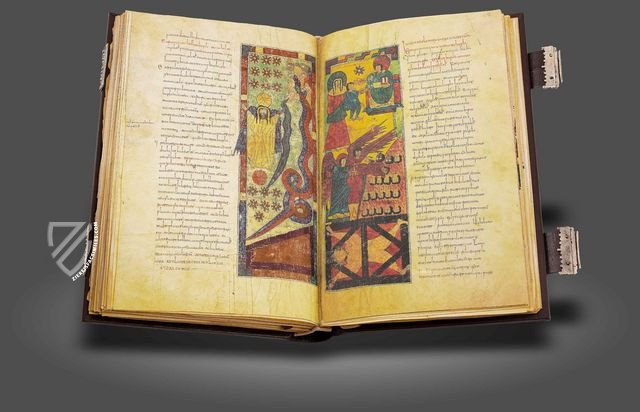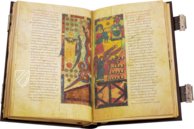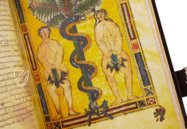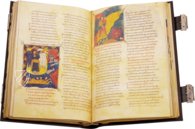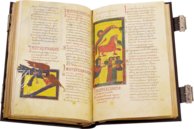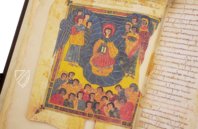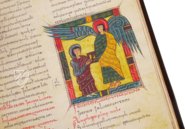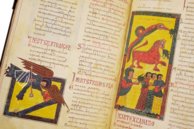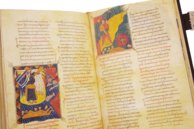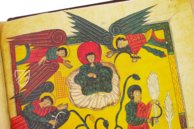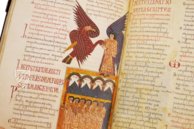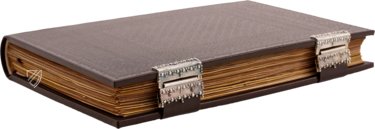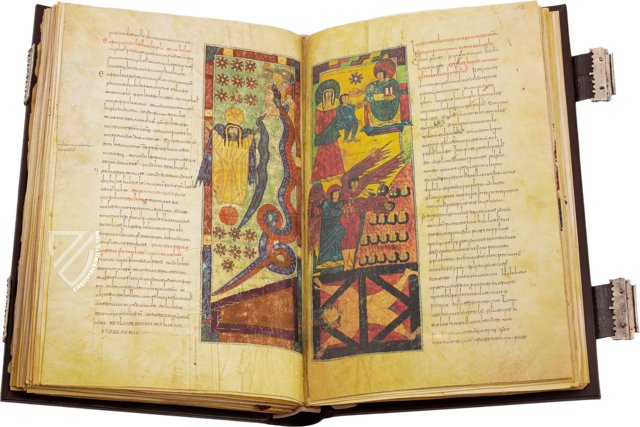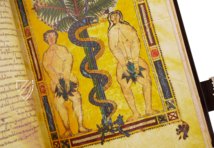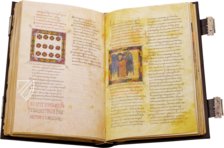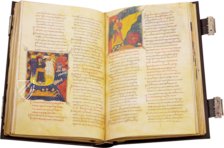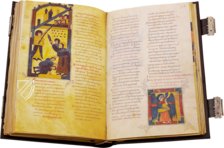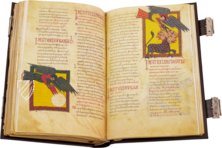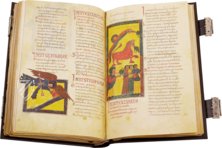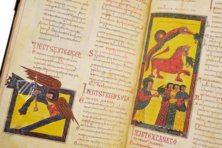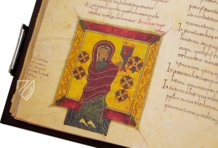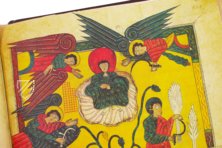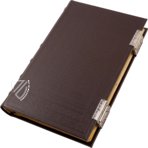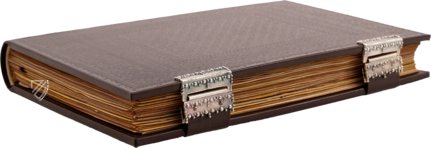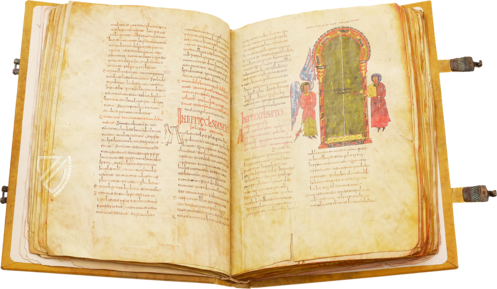Beatus of Liébana - Escorial Codex
The library of the famous monastery of San Lorenzo de El Escorial, built in the 16th century by King Philip II, a great lover of the fine arts, preserves a true treasure of the Spanish Beatus tradition: the so-called Escorial Beatus. This impressive codex was probably written around 950 in the scriptorium of San Millán de la Cogolla, famous for its magnificent Beatus manuscripts. Beatus of Liébana's influential commentary on the Revelation of John became a genre in its own right in the early Middle Ages, producing dozens of magnificent manuscripts throughout the Middle Ages. The Escorial Beatus also has some iconographic peculiarities that make reading and studying the magnificent miniatures a real pleasure. An illuminator named Florentinus endowed the codex with 52 large miniatures, which are distinguished, among other things, by their monochromatic backgrounds in bright colors - mostly yellow - setting John's visions in an abstract world.
Beatus of Liébana - Escorial Codex
Some of the most significant names of Spanish history are tied with the Beatus from Escorial. The manuscript features some iconographic peculiarities that make the reading and study of the marvelous miniatures a true pleasure. The Escorial Codex is presumed to originate before the year 1000 from the famous scriptorium of San Millán de la Cogolla. In the course of its own history though, it reached one of the most significant locations in all of Spanish history: the famous library of the monastery of San Lorenzo de El Escorial, which king Philipp II, a true friend of fine art, had built in the 16th century. With its 52 preserved miniatures, the Escorial Codex is one of the gems among the Beatus manuscripts!
Angel, Knight, Monster…
The manuscript from the library of the Escorial contains the famous Apocalypse commentary by Beatus of Liébana in its 304 pages. This text is the magnum opus of the Asturian monk and theologian Beatus of Liébana (deceased sometime after 798), which he completed ca. 800. This commentary to the wonderful Revelation of John comprised the foundation for one of the most significant book genres of the Middle Ages in northern Spain: the so-called Beatus manuscripts. In comprehensive, large-format codices, the biblical text was written down together with the commentary of Beatus and was usually richly illustrated with magnificent miniatures. The text of the Apocalypse with its mysterious, sometimes terrifying, sometimes simply admirable designs and scenes thereby offered the illuminators the best opportunity to exercise the most exceptional pictorial inventions and give their imaginations free range. True masterpieces of illumination of the High Middle Ages originated in this way!
A Beatus in the Royal Monastic-Library
The Escorial Codex belongs among these masterpieces. This famous manuscript was probably made in the scriptorium of the important San Millán de la Cogolla monastery ca. 950. This scriptorium in San Millán is famous for its magnificent Beatus manuscripts, of which other specimens are still in existence. It is probably because of its excellent quality that the codex found its way from this famous site of origin to another important place in Spanish history: El Escorial. Today the Beatus manuscript is found in the library of the monastery of San Lorenzo de El Escorial, which King Philipp II had built in the 16th century.
Original Images of a Great Master
Contained in the 304 pages of the Escorial Codex are a total of 52 miniatures. These distinguish themselves on the one hand through their great artistry and on the other through some iconographic peculiarities. The miniatures are depicted against a monochrome background, usually luminous yellow. Prominent colors of the painting, alongside this yellow, include various tones of green, red, and ocher. The scenes are laid out strictly two-dimensionally. Particularly expressive, for example, is the depiction of Adam and Eve. The full-page miniature presents both figures to the left and right of the tree, around whose trunk the two-colored snake winds. The miniatures were encircled by gorgeous frames, which were frequently overlapped by figures, a marker of great creativity and mastery. The figures of the angels with their great jagged wings are particularly impressive. The miniaturist Florentinus could possibly be identified as the master of these glories. He is known for his copy of the Job Commentaries of Pope Gregory I, which is found today in the Spanish National Library in Madrid.
Codicology
- Alternative Titles
- Beatus Escorialensis
Escorial Beatus
Beato de Liebana de la Biblioteca Escurialense
Codex Escurialensis
Beato del Escorial - Size / Format
- 304 pages / 39.5 × 22.5 cm
- Origin
- Spain
- Date
- ca. 950
- Epochs
- Style
- Genre
- Language
- Script
- Carolingian minuscule
- Illustrations
- 52 large to full-page miniatures
- Content
- Commentary on the Book of Revelation by Beatus of Liébana
- Artist / School
- Beatus of Liébana (died after 798) (author)
Florencio and Sancho (illuminator)
Beatus of Liébana - Escorial Codex
The Mighty Angel with the Little Book
Revelation 10 and 11 describes the coming of a “mighty angel” who sets his right foot on the sea and his left foot on the land; his cry unleashes seven thunders and seven secrets that are not to be written down by St. John. The angel then gives John a small book, telling him to eat it and that although it will make his stomach bitter, it will taste sweet in his mouth. John is then given a measuring rod to measure the temple of God, its altar, and those worshipping there.

Beatus of Liébana - Escorial Codex
The Fall of Man
This miniature marvelously condenses the events of Genesis 3:1-6, in which Adam and Eve are deceived by the serpent and commit the original sin of eating from the tree of the knowledge of good and evil. The roots of the tree are planted in the decorative frame and its branches exceed this border, which makes the tree appear as though Adam and Eve were standing behind it.
Adam and Eve are depicted with thick limbs and wide eyes that stare intently, but it is not the serpent with blue and yellow scales they are gazing at – they are shocked at each other’s nakedness and are depicted with the fig-leaves that they sewed together to cover themselves. Distilled to only the most crucial visual elements, the miniature is wonderfully clear and expressive.
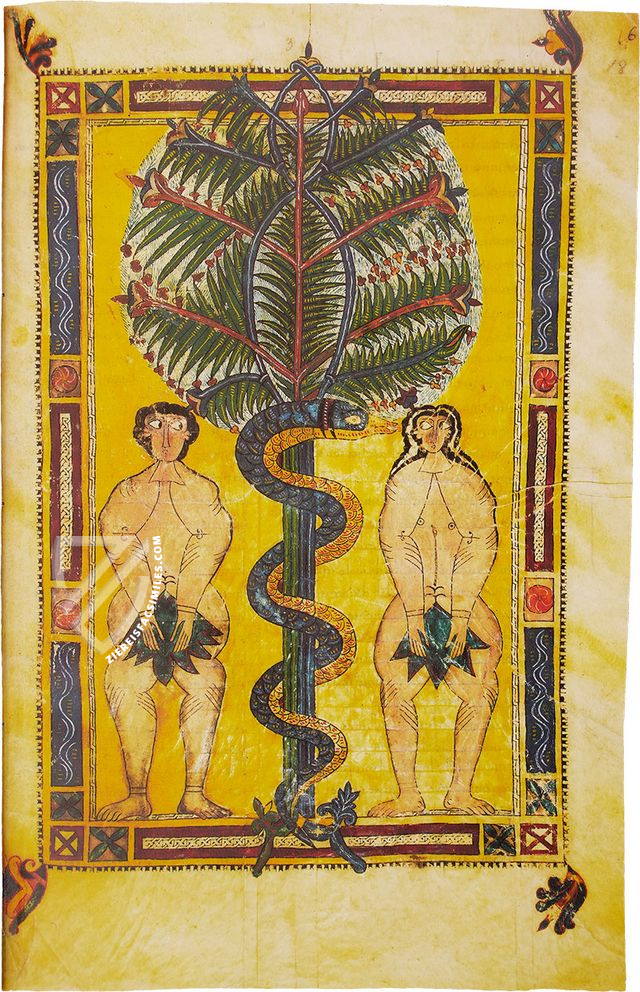
#1 Beato del Escorial
Language: Spanish
- Treatises / Secular Books
- Apocalypses / Beatus
- Astronomy / Astrology
- Bestiaries
- Bibles / Gospels
- Chronicles / History / Law
- Geography / Maps
- Saints' Lives
- Islam / Oriental
- Judaism / Hebrew
- Single Leaf Collections
- Leonardo da Vinci
- Literature / Poetry
- Liturgical Manuscripts
- Medicine / Botany / Alchemy
- Music
- Mythology / Prophecies
- Psalters
- Other Religious Books
- Games / Hunting
- Private Devotion Books
- Other Genres
- Afghanistan
- Armenia
- Austria
- Belgium
- Colombia
- Croatia
- Cyprus
- Czech Republic
- Denmark
- Egypt
- Ethiopia
- France
- Germany
- Greece
- Hungary
- India
- Iran
- Iraq
- Israel
- Italy
- Japan
- Lebanon
- Luxembourg
- Mexico
- Morocco
- Netherlands
- Palestine
- Peru
- Poland
- Portugal
- Russia
- Serbia
- Spain
- Sri Lanka
- Sweden
- Switzerland
- Syria
- Turkey
- Ukraine
- United Kingdom
- United States
- Uzbekistan
- Aboca Museum
- Ajuntament de Valencia
- Akademie Verlag
- Akademische Druck- u. Verlagsanstalt (ADEVA)
- Aldo Ausilio Editore - Bottega d’Erasmo
- Alecto Historical Editions
- Alkuin Verlag
- Almqvist & Wiksell
- Amilcare Pizzi
- Andreas & Andreas Verlagsbuchhandlung
- Archa 90
- Archiv Verlag
- Archivi Edizioni
- Arnold Verlag
- ARS
- Ars Magna
- ArtCodex
- AyN Ediciones
- Azimuth Editions
- Badenia Verlag
- Bärenreiter-Verlag
- Belser Verlag
- Belser Verlag / WK Wertkontor
- Benziger Verlag
- Bernardinum Wydawnictwo
- BiblioGemma
- Biblioteca Apostolica Vaticana (Vaticanstadt, Vaticanstadt)
- Bibliotheca Palatina Faksimile Verlag
- Bibliotheca Rara
- Boydell & Brewer
- Bramante Edizioni
- Bredius Genootschap
- Brepols Publishers
- British Library
- C. Weckesser
- Caixa Catalunya
- Canesi
- CAPSA, Ars Scriptoria
- Caratzas Brothers, Publishers
- Carus Verlag
- Casamassima Libri
- Chavane Verlag
- Christian Brandstätter Verlag
- Circulo Cientifico
- Club Bibliófilo Versol
- Club du Livre
- CM Editores
- Collegium Graphicum
- Collezione Apocrifa Da Vinci
- Comissão Nacional para as Comemorações dos Descobrimentos Portugueses
- Coron Verlag
- Corvina
- CTHS
- D. S. Brewer
- Damon
- De Agostini/UTET
- De Nederlandsche Boekhandel
- De Schutter
- Deuschle & Stemmle
- Deutscher Verlag für Kunstwissenschaft
- DIAMM
- Droz
- E. Schreiber Graphische Kunstanstalten
- Ediciones Boreal
- Ediciones Grial
- Ediclube
- Edições Inapa
- Edilan
- Editalia
- Edition Deuschle
- Edition Georg Popp
- Edition Leipzig
- Edition Libri Illustri
- Editiones Reales Sitios S. L.
- Éditions de l'Oiseau Lyre
- Editions Medicina Rara
- Editorial Casariego
- Editorial Mintzoa
- Editrice Antenore
- Editrice Velar
- Edizioni Edison
- Egeria, S.L.
- Eikon Editores
- Electa
- Emery Walker Limited
- Enciclopèdia Catalana
- Eos-Verlag
- Ephesus Publishing
- Ernst Battenberg
- Eugrammia Press
- Extraordinary Editions
- Fackelverlag
- Facsimila Art & Edition
- Facsimile Editions Ltd.
- Facsimilia Art & Edition Ebert KG
- Faksimile Verlag
- Feuermann Verlag
- Folger Shakespeare Library
- Franco Cosimo Panini Editore
- Friedrich Wittig Verlag
- Fundación Hullera Vasco-Leonesa
- G. Braziller
- Gabriele Mazzotta Editore
- Gebr. Mann Verlag
- Gesellschaft für graphische Industrie
- Getty Research Institute
- Giovanni Domenico de Rossi
- Giunti Editore
- Graffiti
- Grafica European Center of Fine Arts
- Guido Pressler
- Guillermo Blazquez
- Gustav Kiepenheuer
- H. N. Abrams
- Harrassowitz
- Helikon
- Hendrickson Publishers
- Henning Oppermann
- Herder Verlag
- Hes & De Graaf Publishers
- Hoepli
- Holbein-Verlag
- Hortus Deliciarum
- Houghton Library
- Hugo Schmidt Verlag
- Idion Verlag
- Il Bulino, edizioni d'arte
- ILte
- Imago
- Insel Verlag
- Instituto Nacional de Antropología e Historia
- Istituto dell'Enciclopedia Italiana - Treccani
- Istituto Ellenico di Studi Bizantini e Postbizantini
- Istituto Geografico De Agostini
- Istituto Poligrafico e Zecca dello Stato
- Italarte Art Establishments
- J. Thorbecke
- Jan Thorbecke Verlag
- Johnson Reprint Corporation
- Josef Stocker
- Josef Stocker-Schmid
- Jugoslavija
- Karl W. Hiersemann
- Kasper Straube
- Kaydeda Ediciones
- Kindler Verlag / Coron Verlag
- Kodansha International Ltd.
- Konrad Kölbl Verlag
- Kurt Wolff Verlag
- La Liberia dello Stato
- La Linea Editrice
- La Meta Editore
- Lambert Schneider
- Landeskreditbank Baden-Württemberg
- Leo S. Olschki
- Les Incunables
- Library of Congress
- Libreria Musicale Italiana
- Lichtdruck
- Lito Immagine Editore
- Lumen Artis
- Lund Humphries
- M. Moleiro Editor
- Maison des Sciences de l'homme et de la société de Poitiers
- Manuscriptum
- Martinus Nijhoff
- Maruzen-Yushodo Co. Ltd.
- MASA
- McGraw-Hill
- Militos
- Millennium Liber
- Müller & Schindler
- Nahar and Steimatzky
- National Library of Wales
- Neri Pozza
- Nova Charta
- Oceanum Verlag
- Odeon
- Orbis Mediaevalis
- Orbis Pictus
- Österreichische Staatsdruckerei
- Oxford University Press
- Pageant Books
- Parzellers Buchverlag
- Patrimonio Ediciones
- Pattloch Verlag
- PIAF
- Pieper Verlag
- Plon-Nourrit et cie
- Prestel Verlag
- Princeton University Press
- Prisma Verlag
- Priuli & Verlucca, editori
- Pro Sport Verlag
- Propyläen Verlag
- Pytheas Books
- Quaternio Verlag Luzern
- Reales Sitios
- Recht-Verlag
- Reichert Verlag
- Reichsdruckerei
- Riehn & Reusch
- Roberto Vattori Editore
- Rosenkilde and Bagger
- Roxburghe Club
- Salerno Editrice
- Sarajevo Svjetlost
- Schöck ArtPrint Kft.
- Scolar Press
- Scrinium
- Scripta Maneant
- Scriptorium
- Siloé, arte y bibliofilia
- SISMEL - Edizioni del Galluzzo
- Sociedad Mexicana de Antropología
- Société des Bibliophiles & Iconophiles de Belgique
- Soncin Publishing
- Sorli Ediciones
- Stainer and Bell
- Studer
- Styria Verlag
- Sumptibus Pragopress
- Szegedi Tudomànyegyetem
- Taberna Libraria
- Tarshish Books
- Taschen
- Tempus Libri
- Testimonio Compañía Editorial
- Thames and Hudson
- The Clear Vue Publishing Partnership Limited
- The Facsimile Codex
- The Folio Society
- The Marquess of Normanby
- The Richard III and Yorkist History Trust
- Tip.Le.Co
- TouchArt
- TREC Publishing House
- TRI Publishing Co.
- Trident Editore
- Typis Regiae Officinae Polygraphicae
- Union Verlag Berlin
- Universidad de Granada
- University of California Press
- University of Chicago Press
- Urs Graf
- Vallecchi
- Van Wijnen
- VCH, Acta Humaniora
- VDI Verlag
- VEB Deutscher Verlag für Musik
- Verlag Anton Pustet / Andreas Verlag
- Verlag Bibliophile Drucke Josef Stocker
- Verlag der Münchner Drucke
- Verlag für Regionalgeschichte
- Verlag Styria
- Vicent Garcia Editores
- W. Turnowsky
- Waanders Printers
- Wiener Mechitharisten-Congregation (Wien, Österreich)
- Wissenschaftliche Buchgesellschaft
- Wydawnictwo Dolnoslaskie
- Xuntanza Editorial
- Zakład Narodowy
- Zollikofer AG

